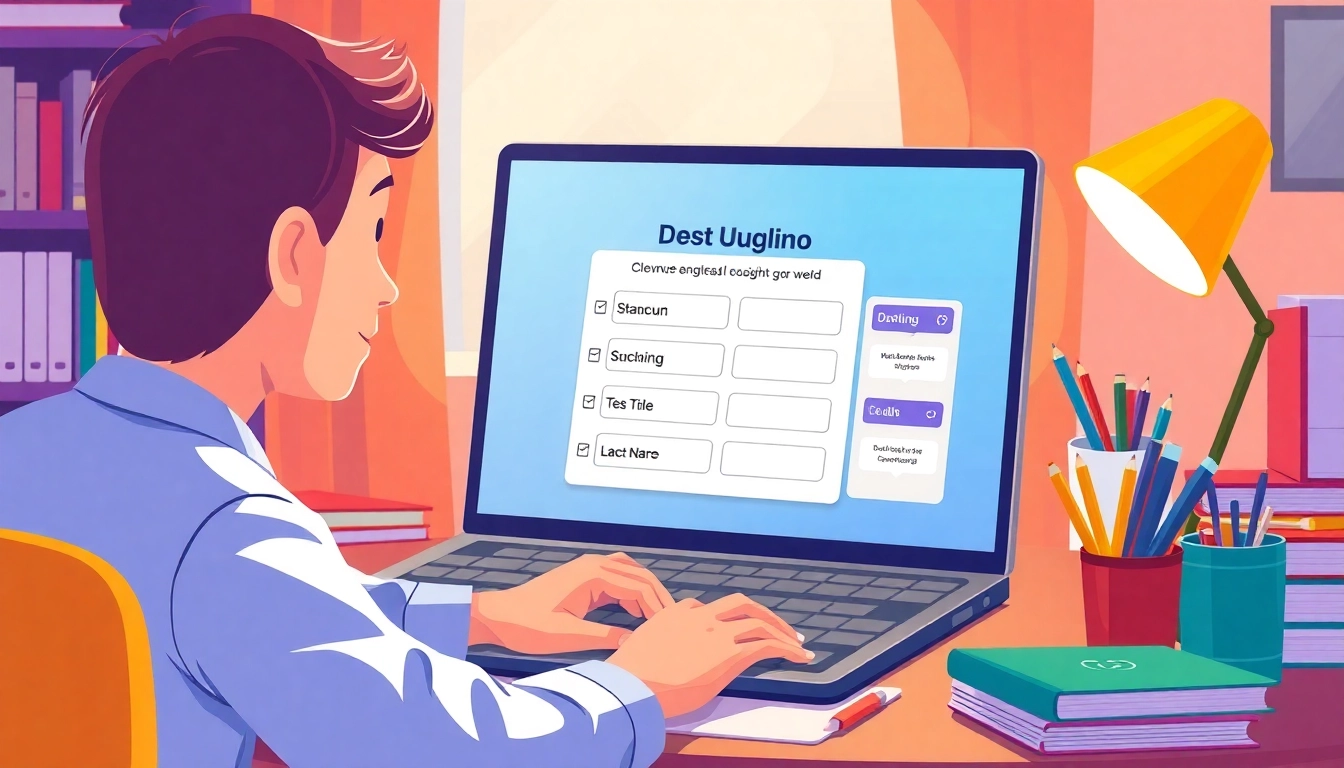Understanding the Duolingo English Practice Test
What is the Duolingo English Practice Test?
The Duolingo English Practice Test is an integral component of the Duolingo English Test (DET), which is a modern, online, and adaptive assessment of English language proficiency. Unlike traditional standardized tests that often require lengthy preparation and costly test centers, the Duolingo test can be taken from the comfort of your own home, making it a popular choice for students and professionals alike. The practice test provides a preview of the actual format, types of questions, and scoring system, offering candidates a valuable opportunity to familiarize themselves with the test structure before taking the official exam.
Why is the Test Important for Language Learners?
As the demand for English proficiency grows in academic and professional settings, the Duolingo English Practice Test serves as a reliable indicator of language skills. It is especially beneficial for non-native speakers seeking admission to universities, job placements, or visa applications. The test is recognized by several institutions globally, granting students with a valid test score the ability to showcase their English proficiency effectively.
Key Features of the Duolingo English Practice Test
The Duolingo English Practice Test boasts several key features that set it apart from other English proficiency tests:
- Accessibility: The test can be taken anytime, anywhere, eliminating the need for scheduled appointments or travel to testing centers.
- Adaptive Testing: The difficulty of questions adjusts based on the tester’s performance, providing a personalized assessment experience.
- Quick Results: Test-takers receive results within 48 hours, enabling rapid feedback on their English proficiency.
- Cost-Effective: As a significantly cheaper alternative to tests like TOEFL or IELTS, it allows greater access to test-takers worldwide.
- Comprehensive Score Report: The score report provides detailed insights into individual skills—reading, writing, listening, and speaking.
How to Access the Duolingo English Practice Test
Step-by-Step Guide to Registering for the Practice Test
Accessing the Duolingo English Practice Test is straightforward. Here’s a step-by-step guide to get you started:
- Create an Account: Visit the official Duolingo English Test website and create an account. One may need to verify their email address before proceeding.
- Navigate to the Practice Test Section: Once logged in, locate the ‘Practice Test’ feature on your dashboard.
- Select Your Preferences: Choose the type of practice test you wish to undertake—either a full-length test or individual sections focusing on reading, writing, listening, or speaking.
- Begin the Test: Follow the on-screen instructions to begin your practice test. Make sure you’re in a quiet environment to simulate actual test conditions.
Free Resources for Duolingo Test Preparation
To enhance your preparation, several free resources are available online:
- Duolingo’s Official Website: Offers practice questions, sample tasks, and study guides specifically designed for the DET.
- YouTube Tutorials: Many educators provide walkthroughs and tips for mastering each section of the exam.
- Online Communities: Joining forums and groups dedicated to Duolingo preparation can connect learners with shared experiences and insights.
- Mobile Apps: Several apps focus on English practice and proficiency, giving users daily exercises that align well with the DET.
Tips for Creating an Effective Study Schedule
Establishing an effective study schedule is crucial for success in the Duolingo English Test. Here are some tips to help you create one:
- Assess Your Current Skill Level: Determine your strengths and weaknesses in English and allocate more study time for the areas requiring improvement.
- Set Realistic Goals: Break your study sessions into manageable tasks and set achievable timelines.
- Incorporate Daily Practice: Aim for regular daily study sessions to build a consistent learning habit.
- Use Different Resources: Engage with a variety of learning materials, such as videos, textbooks, and practice tests, to keep the study experience dynamic.
- Monitor Your Progress: Regularly evaluate your progress to adjust your study schedule as needed to ensure continued improvement.
Practice Strategies for the Duolingo English Test
Types of Questions and How to Tackle Them
The Duolingo English Test is divided into multiple question types, each evaluating different skills. Understanding how to approach each type can significantly enhance your performance:
- Listening Comprehension: Practice focusing on details and main ideas. Use resources like TED Talks or podcasts to immerse yourself in diverse accents and vocabulary.
- Reading Comprehension: Get used to skimming for information and identifying context clues. Reading articles, news stories, and literature can help improve reading speed and comprehension.
- Writing Tasks: Focus on concise and clear expression of ideas. Regularly practice writing short essays or answering prompts to aid fluency and coherence.
- Speaking Tasks: Improve pronunciation and fluidity by practicing with native speakers or using language exchange apps. Rehearsing potential questions commonly asked in the speaking section can build confidence.
Utilizing Mock Tests for Realistic Practice
Engaging in mock tests is one of the most effective ways to prepare. Here’s how to make the most out of practice exams:
- Simulate Exam Conditions: Take practice tests in a quiet environment without interruptions, using a timer to mimic real testing scenarios.
- Review Your Mistakes: After each mock test, carefully analyze your errors and identify areas for improvement.
- Gradually Increase Difficulty: Start with easier tests and progressively challenge yourself with harder ones to build confidence and proficiency.
Common Mistakes to Avoid During Preparation
Being aware of common pitfalls can greatly enhance your preparation process. Here are several mistakes to avoid:
- Procrastination: Delay in studying can lead to last-minute cramming, which is usually ineffective. Stick to your study schedule.
- Ignoring Feedback: Constructive criticism is essential for improvement. Take feedback seriously and implement suggested changes in your practice.
- Overlooking Listening and Speaking: Many candidates focus primarily on reading and writing. Balance your preparation across all areas of language proficiency.
- Not Using Enough Practice Materials: Relying solely on one source may provide a limited perspective. Diversifying your materials can expose you to different question formats.
Tracking Your Progress on the Duolingo Practice Test
Understanding Score Metrics and What They Mean
Comprehending how the scoring system works in the Duolingo English Test is vital for tracking your progress. Scores range from 10 to 160, representing your proficiency level:
- Score Ranges: Understand what score brackets correspond to different levels of proficiency (Basic, Intermediate, Advanced).
- Contextual Understanding: A score of 120 is often seen as a competitive score for university admissions.
- Percentiles: Your score is compared to that of other test-takers, giving you insights into where you stand among peers.
How to Use Feedback for Continuous Improvement
Feedback is an essential tool for continual improvement. Here’s how to leverage it effectively:
- Analyze Practice Test Results: After taking practice tests, assess your performance metrics, focusing on areas with lower scores.
- Adjust Study Techniques: Use feedback to refine your studying methods—overcome weaknesses and enhance strengths.
- Seek Additional Help: If certain patterns arise in your feedback, consider seeking help from tutors or online resources specializing in those areas.
Setting Realistic Language Goals Related to Test Scores
Setting SMART (Specific, Measurable, Achievable, Relevant, Time-bound) goals can significantly enhance your preparation:
- Goal Example: Instead of a vague aim like “improve my English,” set a tangible target such as achieving a score of 110 on the practice test within a specified time frame.
- Progress Check Points: Periodically assess your performance against your goals to stay on track and make necessary adjustments.
Additional Resources for Duolingo Test Preparation
Online Communities and Forums for Support
Being part of a supportive community can positively impact your preparation:
- Social Media Groups: Join Facebook or Reddit groups focused on Duolingo preparation to share tips and ask for clarifications.
- Language Exchange Platforms: Websites like Tandem or HelloTalk connect learners with native speakers for practice and support.
Books and Materials Recommended for Effective Study
Several books and materials can provide a well-rounded approach to studying:
- IELTS/TOEFL Preparation Books: While not directly related, these often provide similar question types that can help enrich your practice.
- Grammar Textbooks: Invest in a grammar book that covers the rules necessary for writing and speaking sections.
Apps and Tools to Enhance Language Learning
Numerous apps and online tools can facilitate language learning processes, including:
- Duolingo App: For daily vocabulary and grammar practice, this popular app remains a great choice.
- Speech Recognition Tools: These can assist you in perfecting your pronunciation and fluency.
- Quizlet: Create flashcards for vocabulary and test yourself on-the-go.



